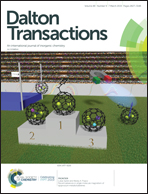Assembly, disassembly and reassembly: a “top-down” synthetic strategy towards hybrid, mixed-metal {Mo10Co6} POM clusters†
Abstract
Polyoxometalates (POMs) are commonly prepared using a “bottom-up” synthetic procedure. The alternative “top-down” approach of disassembling a pre-formed POM unit to generate new synthetic intermediates is promising, but relatively comparatively underused. In this paper, a rationale for the top-down method is provided, demonstrating that this approach can generate compounds that are fundamentally inaccessible from simple bottom-up assembly. We demonstrate this principle through the synthesis of a series of 10, new, mixed-metal, hybrid compounds with the general formula [TBA]2[MoVI10CoII6O30(RpPO3)6(RcCOO)2(L)x(H2O)6] (TBA = tetrabutylammonium, Rp = phosphonate moiety, Rc = carboxylate moiety, L = pyridyl ligand, and x = 2–4), including a one-dimensional polyoxometalate-based coordination polymer. We propose that these structures are generated from {MoxO3x−1} fragments that cannot be accessed from bottom-up assembly alone. The POM clusters are stabilised by three distinct classes of organic ligand – organophosphonate, carboxylate and pyridyl ligands – which can each be substituted independantly, thus providing a controlled route to ligand functionalisation.



 Please wait while we load your content...
Please wait while we load your content...